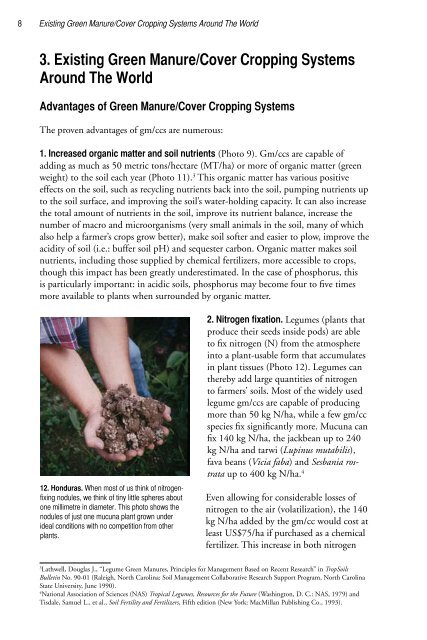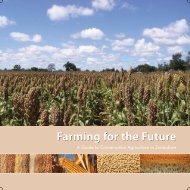Restoring the Soil - Canadian Foodgrains Bank
Restoring the Soil - Canadian Foodgrains Bank
Restoring the Soil - Canadian Foodgrains Bank
You also want an ePaper? Increase the reach of your titles
YUMPU automatically turns print PDFs into web optimized ePapers that Google loves.
8Existing Green Manure/Cover Cropping Systems Around The World3. Existing Green Manure/Cover Cropping SystemsAround The WorldAdvantages of Green Manure/Cover Cropping SystemsThe proven advantages of gm/ccs are numerous:1. Increased organic matter and soil nutrients (Photo 9). Gm/ccs are capable ofadding as much as 50 metric tons/hectare (MT/ha) or more of organic matter (greenweight) to <strong>the</strong> soil each year (Photo 11). 3 This organic matter has various positiveeffects on <strong>the</strong> soil, such as recycling nutrients back into <strong>the</strong> soil, pumping nutrients upto <strong>the</strong> soil surface, and improving <strong>the</strong> soil’s water-holding capacity. It can also increase<strong>the</strong> total amount of nutrients in <strong>the</strong> soil, improve its nutrient balance, increase <strong>the</strong>number of macro and microorganisms (very small animals in <strong>the</strong> soil, many of whichalso help a farmer’s crops grow better), make soil softer and easier to plow, improve <strong>the</strong>acidity of soil (i.e.: buffer soil pH) and sequester carbon. Organic matter makes soilnutrients, including those supplied by chemical fertilizers, more accessible to crops,though this impact has been greatly underestimated. In <strong>the</strong> case of phosphorus, thisis particularly important: in acidic soils, phosphorus may become four to five timesmore available to plants when surrounded by organic matter.12. Honduras. When most of us think of nitrogenfixingnodules, we think of tiny little spheres aboutone millimetre in diameter. This photo shows <strong>the</strong>nodules of just one mucuna plant grown underideal conditions with no competition from o<strong>the</strong>rplants.2. Nitrogen fixation. Legumes (plants thatproduce <strong>the</strong>ir seeds inside pods) are ableto fix nitrogen (N) from <strong>the</strong> atmosphereinto a plant-usable form that accumulatesin plant tissues (Photo 12). Legumes can<strong>the</strong>reby add large quantities of nitrogento farmers’ soils. Most of <strong>the</strong> widely usedlegume gm/ccs are capable of producingmore than 50 kg N/ha, while a few gm/ccspecies fix significantly more. Mucuna canfix 140 kg N/ha, <strong>the</strong> jackbean up to 240kg N/ha and tarwi (Lupinus mutabilis),fava beans (Vicia faba) and Sesbania rostrataup to 400 kg N/ha. 4Even allowing for considerable losses ofnitrogen to <strong>the</strong> air (volatilization), <strong>the</strong> 140kg N/ha added by <strong>the</strong> gm/cc would cost atleast US$75/ha if purchased as a chemicalfertilizer. This increase in both nitrogen3Lathwell, Douglas J., “Legume Green Manures, Principles for Management Based on Recent Research” in Trop<strong>Soil</strong>sBulletin No. 90-01 (Raleigh, North Carolina: <strong>Soil</strong> Management Collaborative Research Support Program, North CarolinaState University, June 1990).4National Association of Sciences (NAS) Tropical Legumes, Resources for <strong>the</strong> Future (Washington, D. C.: NAS, 1979) andTisdale, Samuel L., et al., <strong>Soil</strong> Fertility and Fertilizers, Fifth edition (New York: MacMillan Publishing Co., 1993).
















